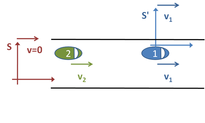Frame of reference
In physics, a frame of reference, or reference frame, is a perspective that one uses to determine if an object is moving.[1] A frame of reference consists of an object or environment that is considered to be stationary. Typically the observer is at rest in the reference frame; in this context, the term is "observational frame of reference."
For example, when you see a ball roll down a street, you can tell the ball is moving because the frame of reference is the streets, whatever may be on the side of the roads, or the Earth. All of these are frames of reference.
All measurements of motion will be compared to a frame of reference.[2] Therefore, the most commonly used frame of reference is Earth itself, even though it moves. Stars are used as a frame of reference when discussing the motions of the Earth.
When we walk from one side of a ship to the other, our frame of reference is the ship; whether the ship is moving is not relevant to that frame of reference.
Inertial frame of reference[change | change source]

An inertial frame of reference is a frame that is either not moving or moving at a constant velocity.[4] In other words, an inertial frame of reference has no net force acting upon it, and therefore Newton's laws of motion are observed.[5]
Inertial reference frames are often used in general relativity and special relativity to describe relative motion of observers or objects and the effects they will endure.
Inertial frames of reference are useful in everyday life as well. For example, consider a situation where two cars are traveling along a road. See Figure 1. If they are separated by a distance of 100 meters, the car in the black is moving at 10 meters per second and the car in front is moving at 5 meters per second, both relative to the ground.
There are three obvious inertial reference frames that can be used to determine when the cars will be even with each other: one where the back car is not moving but the front car is moving backwards at 5 m/s, one where the front car is stationary and the back car is moving forward at 5 m/s, or one where the ground is not moving and the cars are moving at their given velocities. These three perspectives all describe the situation accurately and are physically identical.[5]
Related pages[change | change source]
- General relativity
- Special relativity
- Cartesian coordinate system
- Lorentz transformation
- Principle of relativity
References[change | change source]
- ↑ "Isaac Physics". Isaac Physics. Retrieved 2019-03-10.
- ↑ Oulkar, Apoorv R. (2017-01-06). "All You Need to Know About Frame of Reference in Physics". Toppr Bytes. Retrieved 2019-03-10.[permanent dead link]
- ↑ ohare, Brews (2008-07-22), English: Two inertial frames translating each other, retrieved 2019-03-23
- ↑ Douglas Fields (2015), "Galilean Relativity" (PDF), Physics 262-01 Spring 2018, University of New Mexico, retrieved May 27, 2018
- ↑ 5.0 5.1 "Inertial frames and Newtonian mechanics (from Einstein Light)". newt.phys.unsw.edu.au. Retrieved 2019-03-10.
